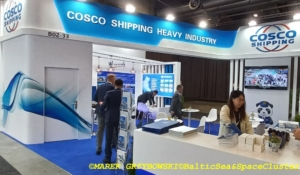The docks in China are full. Shipyards are emptying in South Korea and the EU

 By Marek Grzybowski
By Marek Grzybowski
Chinese shipbuilders recorded a 63% increase in orders for new projects in 2023. This is the result of data provided by CANSI for the period from January to October. Chinese shipbuilders obtained orders for 61.06 million tons in the first ten months of 2023. We can see innovative ferries from China, container ships and bulk carriers in Polish ports almost every day.
Production in Chinese shipyards is developing at full speed. From January to October, ships with a deadweight capacity of 34.56 million tonnes were built in Chinese docks and quays. This means an increase of 12% year on year – reports the China Association of the National Shipbuilding Industry (CANSI) in the latest announcement.
The order portfolio – 133.82 million dwt
“At the end of October, the order portfolio of Chinese shipyards amounted to 133.82 million dwt, which means an increase of 28.1% year on year,” CANSI emphasizes. China’s shipbuilding industry exports amount to 29.63 million tons. This means an increase in deliveries to foreign recipients by 14.3% year on year.
This trend continues, as new contracts reached 57.44 million tons. CANSI estimated the increase in new orders from outside China at exactly 69.5%. The total volume of export orders after 10 months of this year amounted to 125.56 million tons. This means an increase in demand for Chinese shipbuilding production by 34.5%.
Exports drive China’s shipyards
October was extremely dynamic. The construction of new ships increased at a rate of 85.7% compared to last year. Orders for new units increased by 94.1%. External demand contributed to this. Orders for ships placed by foreign contractors increased to 93.8% of the domestic volume.
At the end of October, Chinese shipbuilding production accounted for 49.7% of the global shipbuilding market share. However, orders for new ships accounted for as much as 67% of the market.
As a result, the Korean shipbuilding industry had to acknowledge the quantitative advantage of Chinese shipyards. Price competition and the increasing quality of production of Chinese shipyards have been changing the global image of the new ship production industry for several years.
At the end of 2023, it is already known that the shipyard’s order portfolio from the Republic of Korea gives it second place in global shipbuilding production. This year, Korean shipyards acquired orders for 9.55 million CGT. This means a decline in contracts by 39% compared to the previous year – calculated analysts from Clarksons Research.
The total of global contracts reached CGT 38.03 million during 11 months this year. In shipyards this year Orders were placed for 1,746 ships. This means that within 11 months, 21% fewer orders for new construction were placed in shipyards than in 2022.
Fewer ships in South Korean shipyards
Korean shipyards were assured of production that was 21% higher in the same period last year. Chinese shipyards outperformed Korean players, gaining 21.89 million CGT in new orders. There was a 6% decline (in CGT) compared to 2022.
Korean shipbuilding groups have obtained orders for the construction of 201 ships this year. During this time, Chinese shipyards signed contracts for 995 ships. So, in 2023, Chinese shipyards will take first place in terms of new contracts for the third year in a row.
Shipbuilders from the Republic of Korea are leading in terms of orders for ships with a high degree of technology, such as LNG tankers. Thanks to this approach, for example, HD Korea Shipbuilding & Offshore Engineering (HD KSOE), a leading Korean shipbuilding holding, exceeded the value of its annual procurement program by 36%. HD KSOE reports that the value of contracts is currently USD 15.74 billion.
Samsung Heavy Industries achieved 69% of its 2023 business target, while Hanwha Ocean, formerly Daewoo Shipbuilding & Marine Engineering (DSME), achieved just 43%.
One shipyard on the wave, the rest in the wake
Problems with order portfolios appeared already in the middle of the year. Hyundai Samho was then the only South Korean shipyard whose orders had already exceeded this year’s business target. During the first six months, the shipyard received orders worth USD 5.83 billion. This was more than double the business goal of $2.6 billion. For comparison, in 2022 the shipyard obtained contracts worth USD 8.6 billion.
Other shipyards in the Republic of Korea fared worse. Two sister companies belonging to HD KSOE, i.e. HD Hyundai Heavy Industries Co. and Hyundai Mipo Dockyard Co., achieved mid-year business goals of 56% and 80%, respectively. Samsung Heavy Industries Co. and Hanwha Ocean Co., formerly Daewoo Shipbuilding & Marine Engineering Co. (DSME), achieved only slightly more than half of the assumed goals.
Hyundai Samho focuses on high-value vessels such as LNG and LPG tankers. It also builds mega-container ships. The high-value contracts account for 32 of the 34 the yard has accepted in new orders this year. But one swallow does not make a spring. Korean industry cannot withstand Chinese competition.
– The prices of our ships are about 20% higher than those of Chinese shipyards, but foreign shipowners place orders with us because we meet delivery deadlines and meet quality expectations – Seo Chang-soo, administrative director of Hyundai Samho, explained the situation.
Unfortunately, this formulation does not apply to other shipyards, including European ones. Driven by ship prices, European shipowners, including PŻM and Chipolbrok, are ordering new vessels in China. And they receive ships that we can also see in Polish ports. The Chinese showcase includes, among others: Stena Line ferries serving the Gdynia-Karlskrona connection.
